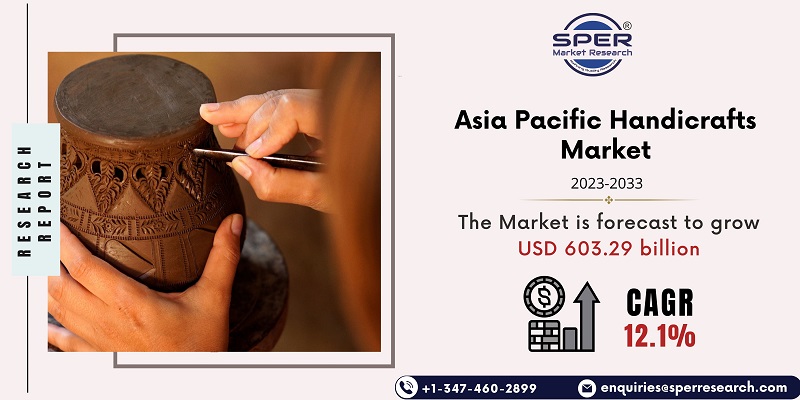
Asia Pacific Handicrafts Market Growth, Size, Trends, Share, Revenue, Demand and Future Outlook
Asia Pacific Handicrafts Market Size- By Product Type, By End User, By Distribution Channel- Regional Outlook, Competitive Strategies and Segment Forecast to 2033
| Published: Jan-2024 | Report ID: FMCG2416 | Pages: 1 - 159 | Formats*: |
| Category : Consumer & Retail | |||


| Report Metric | Details |
| Market size available for years | 2019-2033 |
| Base year considered | 2022 |
| Forecast period | 2023-2033 |
| Segments covered | By Product Type, By End Use, By Distribution Channel |
| Regions covered | Australia, China, India, Indonesia, Japan, Malaysia, Pakistan, South Korea, Thailand, Others |
| Companies Covered | Handicraft Collections (India) Pvt. Ltd., Mariyam Handicraft, Naraiphand Co., Ltd., Pakistan Handicraft, Sharco Enterprises, Sindh Handicrafts, Thai International Handicraft Ltd., Others |
- Art and Craft Exhibitions/Markets
- Artisans and Craftsmen
- Cultural Organizations
- Exporters and Importers
- Individuals interested in unique, handmade products for personal use or gifting
- Interior Designers
- Retailers and Artisanal Shops
- Tourism Industry
- Other
| By Product Type: |
|
| By End Use: |
|
| By Distribution Channel: |
|
- Asia Pacific Handicrafts Market Size (FY’2023-FY’2033)
- Overview of Asia Pacific Handicrafts Market
- Segmentation of Asia Pacific Handicrafts Market By Product Type (Artmetal Ware, Attars and Agarbattis, Embroidered and Crocheted Goods, Handprinted Textiles and Scarves, Imitation Jewelry, Pottery and Glass Wares, Sculptures, Woodware, Zari and Zari Goods, Others)
- Segmentation of Asia Pacific Handicrafts Market By End Use (Residential, Commercial)
- Segmentation of Asia Pacific Handicrafts Market By Distribution Channel (Departmental Stores, Independent Retailers, Mass Retailers, Online Stores, Specialty Stores, Others)
- Statistical Snap of Asia Pacific Handicrafts Market
- Expansion Analysis of Asia Pacific Handicrafts Market
- Problems and Obstacles in Asia Pacific Handicrafts Market
- Competitive Landscape in the Asia Pacific Handicrafts Market
- Impact of COVID-19 and Demonetization on Asia Pacific Handicrafts Market
- Details on Current Investment in Asia Pacific Handicrafts Market
- Competitive Analysis of Asia Pacific Handicrafts Market
- Prominent Players in the Asia Pacific Handicrafts Market
- SWOT Analysis of Asia Pacific Handicrafts Market
- Asia Pacific Handicrafts Market Future Outlook and Projections (FY’2023-FY’2033)
- Recommendations from Analyst
1.1. Scope of the report1.2. Market segment analysis
2.1. Research data source2.1.1. Secondary Data2.1.2. Primary Data2.1.3. SPER’s internal database2.1.4. Premium insight from KOL’s2.2. Market size estimation2.2.1. Top-down and Bottom-up approach2.3. Data triangulation
4.1. Driver, Restraint, Opportunity and Challenges analysis4.1.1. Drivers4.1.2. Restraints4.1.3. Opportunities4.1.4. Challenges4.2. COVID-19 Impacts of the Asia Pacific Handicrafts Market
5.1. SWOT Analysis5.1.1. Strengths5.1.2. Weaknesses5.1.3. Opportunities5.1.4. Threats5.2. PESTEL Analysis5.2.1. Political Landscape5.2.2. Economic Landscape5.2.3. Social Landscape5.2.4. Technological Landscape5.2.5. Environmental Landscape5.2.6. Legal Landscape5.3. PORTER’s Five Forces5.3.1. Bargaining power of suppliers5.3.2. Bargaining power of buyers5.3.3. Threat of Substitute5.3.4. Threat of new entrant5.3.5. Competitive rivalry5.4. Heat Map Analysis
6.1. Asia Pacific Handicrafts Market Manufacturing Base Distribution, Sales Area, Product Type6.2. Mergers & Acquisitions, Partnerships, Product Launch, and Collaboration in Asia Pacific Handicrafts Market
7.1. Asia Pacific Handicrafts Market Value Share and Forecast, By Product Type, 2023-20337.2. Artmetal Ware7.3. Attars and Agarbattis7.4. Embroidered and Crocheted Goods7.5. Handprinted Textiles and Scarves7.6. Imitation Jewelry7.7. Pottery and Glass Wares7.8. Sculptures7.9. Woodware7.10. Zari and Zari Goods7.11. Others
8.1. Asia Pacific Handicrafts Market Value Share and Forecast, By End Use, 2023-20338.2. Residential8.3. Commercial
9.1. Asia Pacific Handicrafts Market Value Share and Forecast, By Distribution Channel, 2023-20339.2. Departmental Stores9.3. Independent Retailers9.4. Mass Retailers9.5. Online Stores9.6. Specialty Stores9.7. Others
10.1. Asia Pacific Handicrafts Market Size and Market Share
11.1. Asia Pacific Handicrafts Market Size and Market Share By Product Type (2019-2026)11.2. Asia Pacific Handicrafts Market Size and Market Share By Product Type (2027-2033)
12.1. Asia Pacific Handicrafts Market Size and Market Share By End Use (2019-2026)12.2. Asia Pacific Handicrafts Market Size and Market Share By End Use (2027-2033)
13.1. Asia Pacific Handicrafts Market Size and Market Share By Distribution Channel (2019-2026)13.2. Asia Pacific Handicrafts Market Size and Market Share By Distribution Channel (2027-2033)
14.1. Asia Pacific Handicrafts Market Size and Market Share By Region (2019-2026)14.2. Asia Pacific Handicrafts Market Size and Market Share By Region (2027-2033)14.3. Australia14.4. China14.5. India14.6. Indonesia14.7. Japan14.8. Malaysia14.9. Pakistan14.10. South Korea14.11. Thailand14.12. Others
15.1. Handicraft Collections (India) Pvt. Ltd15.1.1. Company details15.1.2. Financial outlook15.1.3. Product summary15.1.4. Recent developments15.2. Mariyam Handicraft15.2.1. Company details15.2.2. Financial outlook15.2.3. Product summary15.2.4. Recent developments15.3. Naraiphand Co., Ltd.15.3.1. Company details15.3.2. Financial outlook15.3.3. Product summary15.3.4. Recent developments15.4. Pakistan Handicraft15.4.1. Company details15.4.2. Financial outlook15.4.3. Product summary15.4.4. Recent developments15.5. Sharco Enterprises15.5.1. Company details15.5.2. Financial outlook15.5.3. Product summary15.5.4. Recent developments15.6. Sindh Handicrafts15.6.1. Company details15.6.2. Financial outlook15.6.3. Product summary15.6.4. Recent developments15.7. Thai International Handicraft Ltd.15.7.1. Company details15.7.2. Financial outlook15.7.3. Product summary15.7.4. Recent developments15.8. Others
SPER Market Research’s methodology uses great emphasis on primary research to ensure that the market intelligence insights are up to date, reliable and accurate. Primary interviews are done with players involved in each phase of a supply chain to analyze the market forecasting. The secondary research method is used to help you fully understand how the future markets and the spending patterns look likes.
The report is based on in-depth qualitative and quantitative analysis of the Product Market. The quantitative analysis involves the application of various projection and sampling techniques. The qualitative analysis involves primary interviews, surveys, and vendor briefings. The data gathered as a result of these processes are validated through experts opinion. Our research methodology entails an ideal mixture of primary and secondary initiatives.



Frequently Asked Questions About This Report
PLACE AN ORDER
Year End Discount
Sample Report
Pre-Purchase Inquiry
NEED CUSTOMIZATION?
Request CustomizationCALL OR EMAIL US
100% Secure Payment






Related Reports
Our Global Clients
Our data-driven insights have influenced the strategy of 200+ reputed companies across the globe.




















